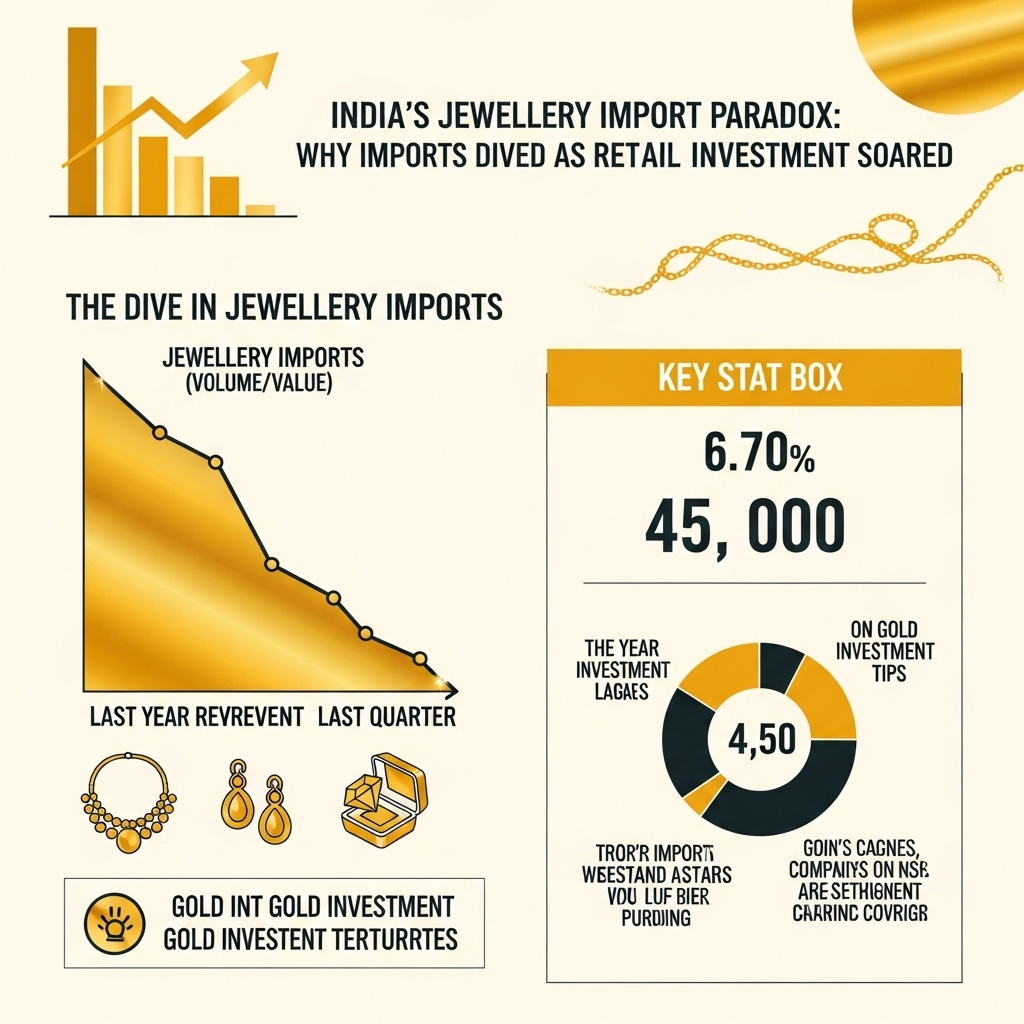The Curious Case of Gold in India: Jewellery Dives, Investment Soars
In the dynamic world of gold investment, India presents a fascinating paradox. As global and domestic markets grapple with fluctuating economic landscapes, a peculiar trend has emerged within the subcontinent: while jewellery imports have seen a significant downturn, the appetite for gold as a retail investment has simultaneously surged. For astute investors keen on navigating the currents of the gold market, understanding this divergence is not just insightful – it’s crucial for optimizing your investment strategy. This post will delve into the core reasons behind this intriguing phenomenon, dissecting the market trends that have led to this split and illuminating the potential financial benefits and implications for your gold portfolio.
We’ll explore the key economic and consumer behavior shifts that have impacted jewellery demand, from changing consumption patterns to the influence of import duties and government policies. Simultaneously, we’ll examine the factors driving the increased attractiveness of gold as an investment vehicle, including its role as a safe-haven asset amidst economic uncertainty, its appeal as a store of value, and the growing accessibility of various investment avenues. By unravelling this intricate relationship between jewellery imports and retail investment, this analysis aims to equip you with a clearer perspective on the current Indian gold market, empowering you to make more informed decisions for your financial future. Understanding this anomaly is vital for anyone looking to capitalize on gold’s enduring appeal in one of the world’s largest gold-consuming nations.
Gold Market Analysis and Key Insights
The notable divergence between falling jewellery imports and rising retail investment in India underscores a profound shift in how gold is perceived and acquired by consumers. Historically, gold in India was synonymous with physical jewellery, serving both as an adornment and a traditional store of value. However, current trends indicate a decisive pivot towards gold as a pure investment asset, driven by evolving financial awareness and the availability of sophisticated investment instruments.
Shifting Consumer Preferences
The decline in jewellery imports, despite a robust domestic economy, suggests that discretionary spending on gold for adornment or ceremonial purposes has softened. Instead, consumers are increasingly channeling their savings into gold investment vehicles. This shift is partly due to rising gold prices making jewellery less affordable, but more significantly, it reflects a growing preference for security, purity, and convenience offered by modern investment avenues over traditional physical forms.
Financialization and Current Market Trends
The Indian gold market is witnessing a strong trend towards financialization. Instruments like Sovereign Gold Bonds (SGBs), Gold Exchange Traded Funds (ETFs), and digital gold platforms have gained significant traction. SGBs, in particular, offer a government-backed alternative with an additional interest rate and tax benefits on maturity, drawing substantial retail interest. Current global uncertainties, inflationary pressures, and a weaker rupee have also bolstered gold’s appeal as a safe-haven asset, driving up demand for these investment products. Data indicates sustained high subscriptions for SGB tranches and growing Assets Under Management (AUM) for Gold ETFs, even as physical gold demand for fabrication has moderated.
Investment Advantages and Considerations
Gold offers several compelling benefits as an investment: it acts as an effective hedge against inflation and currency depreciation, provides portfolio diversification, and serves as a reliable asset during economic downturns. Its liquidity, particularly in digital and ETF forms, is also a significant advantage. However, investors must consider price volatility, which can impact short-term returns, and for physical gold, concerns around storage security and purity.
Strategic Investment Advice
For Indian investors, experts recommend a balanced approach to gold investment. Allocating a portion of one’s portfolio (typically 5-15%) to gold can enhance stability. Prioritizing financial instruments like SGBs or Gold ETFs over physical gold is advisable due to their superior security, liquidity, and cost-effectiveness. A long-term investment horizon is crucial to mitigate short-term price fluctuations and fully capitalize on gold’s value appreciation potential. Consulting a financial advisor can help tailor gold investments to individual risk appetites and financial goals.

Gold Investment Strategies and Options
The decline in jewellery imports amidst a rise in retail investment highlights a maturing Indian investor base, increasingly discerning about efficient gold exposure. Traditional physical gold, particularly jewellery, incurs significant making charges and GST, eroding its investment value. Modern avenues offer purer, more liquid, and often more tax-efficient ways to invest.
Investment Options & Strategies: Investors can opt for physical gold (bars, coins) for tangibility, albeit with storage concerns. More appealing are paper gold alternatives. Gold Exchange Traded Funds (ETFs) allow electronic trading, mirroring gold prices with high liquidity. Sovereign Gold Bonds (SGBs), government-backed and interest-bearing (2.5% p.a.), offer tax exemption on maturity (8 years), making them highly attractive. Digital Gold platforms also provide convenience for small investments.
Risk and Portfolio Allocation: Gold serves as a crucial portfolio diversifier and a hedge against inflation and economic uncertainty. While its price can be volatile, a strategic allocation, typically 5-15% of a diversified portfolio, can cushion against market downturns. This shift towards efficient gold instruments reflects a preference for holding the asset without associated fabrication costs and storage risks of jewellery.
Comparison and Market Timing: SGBs uniquely offer interest income and tax efficiency, while ETFs provide liquidity for active traders. Physical gold suits those preferring tangible assets. Market timing for gold often involves buying during economic uncertainty or high inflation, leveraging its safe-haven appeal. However, for most, systematic investment plans (SIPs) into ETFs or regular SGB subscriptions average out costs, reducing the need for precise timing and ensuring consistent exposure. This pivot underscores a strategic move towards pure investment.
Market Performance and Outlook
Historically, India’s gold demand was heavily reliant on imports for jewellery consumption. However, recent data reveals a significant divergence. Gold jewellery imports plunged by over 60% in 2023 compared to the previous year, notably influenced by record-high domestic gold prices and an elevated import duty of 15%. Simultaneously, retail investment in gold, through avenues like Sovereign Gold Bonds (SGBs), gold ETFs, and digital gold, has seen a robust uptick, reflecting a shift in consumer preference from physical jewellery to financial gold assets.
Current market conditions are characterized by this bifurcated trend. Consumers are hesitant to purchase expensive physical jewellery, while investors are drawn to gold as a hedge against persistent inflation and global economic uncertainties. The rupee’s depreciation against the dollar also inflates domestic gold prices, making imports pricier but supporting the intrinsic value for domestic holders. Geopolitical tensions further bolster gold’s appeal as a safe-haven asset.
Looking ahead, this trend is likely to persist. India’s jewellery imports may remain subdued as long as international and domestic gold prices stay elevated and import duties discourage large-scale shipments. Conversely, retail investment in financial gold instruments is predicted to grow, driven by government incentives (like SGB issues) and increasing financial literacy. Economic factors such as global interest rate movements, particularly by the US Federal Reserve, and ongoing inflationary pressures will heavily influence gold’s price trajectory, with lower rates typically supporting gold prices and higher inflation enhancing its appeal as a store of value.
Frequently Asked Questions About Gold Investment
Why are gold jewellery imports falling despite rising retail investment?
This reflects a significant shift towards financial gold instruments like Sovereign Gold Bonds (SGBs) and Gold ETFs. High import duties, rising gold prices, and increased domestic recycling also make imported physical jewellery less attractive for investment purposes compared to other forms.
Does this mean less overall gold demand in India?
Not at all. It indicates a changing preference among investors. While jewellery imports decreased, investment in non-physical gold forms surged, suggesting a move towards more liquid, cost-effective, and efficient gold avenues over traditional physical jewellery.
Are Gold ETFs or Sovereign Gold Bonds (SGBs) better investments than physical gold jewellery?
For pure investment, SGBs and Gold ETFs are generally superior. They eliminate making charges, storage costs, and purity concerns. SGBs also offer attractive interest payments and tax benefits, making them highly efficient investment tools compared to physical jewellery.
How do rising gold prices influence investment choices?
Higher gold prices make large physical jewellery purchases less accessible for many. Investors thus increasingly opt for more affordable entry points like digital gold, Gold ETFs, or SGBs, allowing them to gain exposure to gold’s appreciation without the significant upfront cost of heavy physical pieces.
Is physical gold jewellery still a good investment option?
While culturally significant and often bought for adornment, for pure investment, physical jewellery is less efficient. It typically incurs making charges (10-25%), GST, and involves storage/security risks. Financial instruments offer a more direct and often cheaper way to invest in gold’s price movement.

Final Thoughts on Gold Investment
India’s gold market presents a fascinating paradox: while jewellery imports declined, retail investment surged, revealing a strategic shift among savvy investors. Key takeaways include the growing preference for coins and bars over ornamental gold, driven by better returns and liquidity. Economic factors like import duties and consumer behavior changes have reshaped demand patterns, with investment-grade gold outperforming traditional jewellery segments.
Investment Recommendation: Diversify your gold portfolio beyond jewellery—focus on ETFs, coins, and bars for better liquidity and returns.
Call to Action: Ready to optimize your gold investments? Explore investment-grade options and consult with financial advisors to align your strategy with current market trends. Stay informed, stay ahead.